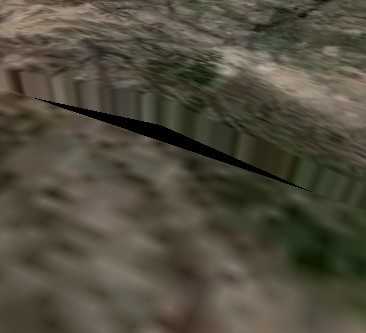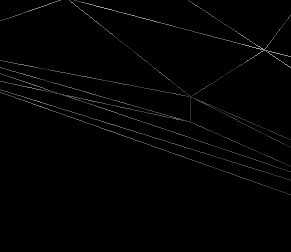标签:
1、WorldWind如何确定与视点相关的地形数据的LOD层级与范围?
问题描述:WW中是如何判断LOD层次的呢,即在什么情况下获得哪一层级的数据?是否只通过相机视点的高度进行判断?
问题切入:要解决这个问题,我先说明一下WW的渲染机制,在渲染线程中,Render函数只负责渲染可渲染物体,而不负责视点的更新和Lod的判断。在m_World.Render(this.drawArgs)中可渲染的物体都是通过另一个更新线程WorkerThreadFunc来控制的,具体由m_World.Update(this.drawArgs)实现。因此要找到这个问题的答案需要从Update着手。重点注意m_World.Update(this.drawArgs)中的两段代码。如下所示:
可渲染物体的递归更新:
if (this.RenderableObjects != null) { this.RenderableObjects.Update(drawArgs); } if (this.m_WorldSurfaceRenderer != null) { this.m_WorldSurfaceRenderer.Update(drawArgs); } if (this.m_projectedVectorRenderer != null) { this.m_projectedVectorRenderer.Update(drawArgs); }
相机视点的高度更新:
if (this.TerrainAccessor != null) { if (drawArgs.WorldCamera.Altitude < 300000) { if (System.DateTime.Now - this.lastElevationUpdate > TimeSpan.FromMilliseconds(500)) { drawArgs.WorldCamera.TerrainElevation = (short)this.TerrainAccessor.GetElevationAt(drawArgs.WorldCamera.Latitude.Degrees, drawArgs.WorldCamera.Longitude.Degrees, 100.0 / drawArgs.WorldCamera.ViewRange.Degrees); this.lastElevationUpdate = System.DateTime.Now; } } else drawArgs.WorldCamera.TerrainElevation = 0; } else { drawArgs.WorldCamera.TerrainElevation = 0; }
问题答案:搜索全局Update,重点关注SurfaceTile的Update和QuadTile的Update。
SurfaceTile的Update:
if(drawArgs.WorldCamera.TrueViewRange < Angle.FromDegrees(3.0f*tileSize) && MathEngine.SphericalDistance( Angle.FromDegrees(centerLatitude), Angle.FromDegrees(centerLongitude), drawArgs.WorldCamera.Latitude, drawArgs.WorldCamera.Longitude) < Angle.FromDegrees( 2.9f*tileSize )& drawArgs.WorldCamera.ViewFrustum.Intersects(m_BoundingBox)) { if(m_NorthWestChild == null || m_NorthEastChild == null || m_SouthWestChild == null || m_SouthEastChild == null) { ComputeChildrenTiles(drawArgs); } else { if(m_NorthEastChild != null) { m_NorthEastChild.Update(drawArgs); } if(m_NorthWestChild != null) { m_NorthWestChild.Update(drawArgs); } if(m_SouthEastChild != null) { m_SouthEastChild.Update(drawArgs); } if(m_SouthWestChild != null) { m_SouthWestChild.Update(drawArgs); } } } else { if(m_NorthWestChild != null) { m_NorthWestChild.Dispose(); m_NorthWestChild = null; } if(m_NorthEastChild != null) { m_NorthEastChild.Dispose(); m_NorthEastChild = null; } if(m_SouthEastChild != null) { m_SouthEastChild.Dispose(); m_SouthEastChild = null; } if(m_SouthWestChild != null) { m_SouthWestChild.Dispose(); m_SouthWestChild = null; } }
QuadTile的Update:
if (DrawArgs.Camera.ViewRange < Angle.FromDegrees(QuadTileSet.TileDrawDistance * tileSize)&& MathEngine.SphericalDistance(CenterLatitude, CenterLongitude,DrawArgs.Camera.Latitude, DrawArgs.Camera.Longitude) < Angle.FromDegrees(QuadTileSet.TileDrawSpread * tileSize)&& DrawArgs.Camera.ViewFrustum.Intersects(BoundingBox)) { if (northEastChild == null || northWestChild == null || southEastChild == null || southWestChild == null) { ComputeChildren(drawArgs); } if (northEastChild != null) { northEastChild.Update(drawArgs); } if (northWestChild != null) { northWestChild.Update(drawArgs); } if (southEastChild != null) { southEastChild.Update(drawArgs); } if (southWestChild != null) { southWestChild.Update(drawArgs); } } else { if (northWestChild != null) { northWestChild.Dispose(); northWestChild = null; } if (northEastChild != null) { northEastChild.Dispose(); northEastChild = null; } if (southEastChild != null) { southEastChild.Dispose(); southEastChild = null; } if (southWestChild != null) { southWestChild.Dispose(); southWestChild = null; } }
在这里我们看到判断Lod的级别主要有三个条件:
1、相机视角范围,视角范围越大,所包含的tileSize就越大;
2、相机与瓦片距离,距离越远,所包含的tileSize也就越大;
3、相机视锥与瓦片是否相交。
相对应我们可以把视角剔除方法理解成以下三步:
1、根据视角范围,画个大圈,把大圈里的大瓦片全加进来;
2、根据相机与瓦片的距离进行细化瓦片,如果太远的瓦片仍然保持很大,而近处的瓦片需要进一步更新,计算子瓦片;
3、每计算一个瓦片都需要判断它是否在视锥里,否则剔除身后看不到的瓦片。
在理解以上三个条件的前提下,需要理解的是视角、距离到底与tileSize有什么关系。对于不同级别影像或地形,ww中设置了相应的大小,根据一定的比例系数和经验参数寻找与距离和视角的关系。即通过调整参数 可控制在怎样的距离下可以看到怎样级别的地形或影像。例如在地形中设置为3.0、2.9等常数,在影像中设置为TileDrawDistance和TileDrawSpread等常数。只是反映了一定的经验参数而已。
2、WorldWind中对地块接边的处理是有裂缝的,采用裙摆设置的原理和方法实现是什么?
问题描述:对于不同级别的地形要进行接边是个很重要的问题,这个问题在我推荐的文献《全球多分辨率虚拟地形环境关键技术的研究》(作者杜莹2005博士)中有详细说明,而WW只是选择了最简单最原始的接地处理,也就是常说的裙摆处理。这种处理方法有很多的不利之处,但是实现方法简便,在此做简单说明。
问题切入:要想追踪这个问题,首先想到的是QuadTile的Update,而不从Render着手。Update就像在炒菜前把所有材料都准备的工作,如果没准备好就不能炒。在QuadTile的Update中,从CreateTileMesh切入,发现了CreateElevatedMesh和CreateFlatMesh的区别,显然裙摆是针对地形网格而做的处理在CreateElevatedMesh再深入到子函数,其中有一段很重要的说明:
/// <summary> /// Builds flat or terrain mesh for current tile//为当前瓦片创建平坦或高程格网 /// </summary> public virtual void CreateTileMesh() { verticalExaggeration = World.Settings.VerticalExaggeration; m_CurrentOpacity = QuadTileSet.Opacity; renderStruts = QuadTileSet.RenderStruts; if (QuadTileSet.TerrainMapped && Math.Abs(verticalExaggeration) > 1e-3) CreateElevatedMesh(); else CreateFlatMesh(); }
在CreateElevatedMesh再深入到子函数,其中有一段很重要的说明:
/// <summary> /// Build the elevated terrain mesh /// </summary> protected virtual void CreateElevatedMesh() { isDownloadingTerrain = true; // Get height data with one extra sample around the tile double degreePerSample = LatitudeSpan / vertexCountElevated; TerrainTile tile = QuadTileSet.World.TerrainAccessor.GetElevationArray(North + degreePerSample, South - degreePerSample, West - degreePerSample, East + degreePerSample, vertexCountElevated + 3); float[,] heightData = tile.ElevationData; int vertexCountElevatedPlus3 = vertexCountElevated / 2 + 3; int totalVertexCount = vertexCountElevatedPlus3 * vertexCountElevatedPlus3; northWestVertices = new CustomVertex.PositionNormalTextured[totalVertexCount]; southWestVertices = new CustomVertex.PositionNormalTextured[totalVertexCount]; northEastVertices = new CustomVertex.PositionNormalTextured[totalVertexCount]; southEastVertices = new CustomVertex.PositionNormalTextured[totalVertexCount]; double layerRadius = (double)QuadTileSet.LayerRadius; // Calculate mesh base radius (bottom vertices) // Find minimum elevation to account for possible bathymetry float minimumElevation = float.MaxValue; float maximumElevation = float.MinValue; foreach (float height in heightData) { if (height < minimumElevation) minimumElevation = height; if (height > maximumElevation) maximumElevation = height; } minimumElevation *= verticalExaggeration; maximumElevation *= verticalExaggeration; if (minimumElevation > maximumElevation) { // Compensate for negative vertical exaggeration minimumElevation = maximumElevation; maximumElevation = minimumElevation; } double overlap = 500 * verticalExaggeration; // 500m high tiles // Radius of mesh bottom grid meshBaseRadius = layerRadius + minimumElevation - overlap; CreateElevatedMesh(ChildLocation.NorthWest, northWestVertices, meshBaseRadius, heightData); CreateElevatedMesh(ChildLocation.SouthWest, southWestVertices, meshBaseRadius, heightData); CreateElevatedMesh(ChildLocation.NorthEast, northEastVertices, meshBaseRadius, heightData); CreateElevatedMesh(ChildLocation.SouthEast, southEastVertices, meshBaseRadius, heightData); BoundingBox = new BoundingBox((float)South, (float)North, (float)West, (float)East, (float)layerRadius, (float)layerRadius + 10000 * this.verticalExaggeration); QuadTileSet.IsDownloadingElevation = false; // Build common set of indexes for the 4 child meshes int vertexCountElevatedPlus2 = vertexCountElevated / 2 + 2; vertexIndexes = new short[2 * vertexCountElevatedPlus2 * vertexCountElevatedPlus2 * 3]; int elevated_idx = 0; for (int i = 0; i < vertexCountElevatedPlus2; i++) { for (int j = 0; j < vertexCountElevatedPlus2; j++) { vertexIndexes[elevated_idx++] = (short)(i * vertexCountElevatedPlus3 + j); vertexIndexes[elevated_idx++] = (short)((i + 1) * vertexCountElevatedPlus3 + j); vertexIndexes[elevated_idx++] = (short)(i * vertexCountElevatedPlus3 + j + 1); vertexIndexes[elevated_idx++] = (short)(i * vertexCountElevatedPlus3 + j + 1); vertexIndexes[elevated_idx++] = (short)((i + 1) * vertexCountElevatedPlus3 + j); vertexIndexes[elevated_idx++] = (short)((i + 1) * vertexCountElevatedPlus3 + j + 1); } } calculate_normals(ref northWestVertices, vertexIndexes); calculate_normals(ref southWestVertices, vertexIndexes); calculate_normals(ref northEastVertices, vertexIndexes); calculate_normals(ref southEastVertices, vertexIndexes); isDownloadingTerrain = false; }
这段注释的意思是说在:创建地形mesh的时候,在网格点的四周围多加一个点用于之后法向量的计算,而使用这种柱状顶点的效果将在法向量计算完后再折叠起来。这就是所谓的裙摆效果。在接下来的calculate_normals中,一眼就能看出折叠函数ProjectOnMeshBase,其具体实现如下:
// Project an elevated mesh point to the mesh base private Point3d ProjectOnMeshBase(Point3d p) { p = p + this.localOrigin; p = p.normalize(); p = p * meshBaseRadius - this.localOrigin; return p; }


声明:本文的原创著作权利属于武汉大学GIS(地理信息系统)专业2009级本科毕业生杨建顺学长,本文的成文仅用于个人学习和研究,在此对原著者表示感谢。
WorldWind源码剖析系列:WorldWind如何确定与视点相关的地形数据的LOD层级与范围
标签:
原文地址:http://www.cnblogs.com/rainbow70626/p/5294095.html